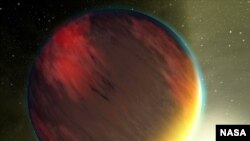A planet’s wobble may greatly enhance its ability to host life, even if the planet is far away from its star, new research says.
Wobbling, or axial shifting, means that a planet changes its tilt much in the same way as a top that’s about to stop spinning.
Extreme wobbling may be explained by competing gravitational pulls between the planets’ star and another nearby planet.
These wobblers could change their orientation within “tens to hundreds of thousands of years – a blink of an eye in geologic terms,” scientists said in a new paper.
A wobbling planet that might otherwise be a frozen world could have liquid water -- thought to be necessary to support life -- because the poles would face the planet’s star, allowing the ice to melt, researchers said.
"Planets like these are far enough from their stars that it would be easy to write them off as frozen, and poor targets for exploration, but in fact, they might be well-suited to supporting life," said Shawn Domagal-Goldman, an astrobiologist at NASA's Goddard Space Flight Center in Greenbelt, Maryland, in a statement. "This could expand our idea of what a habitable planet looks like and where habitable planets might be found."
Researchers say they may have already spotted planets with “crazy tilt-a-world” wobbling.
Around the star Upsilon Andromedae, two enormous planets were found to be inclined at an angle 30 degrees to each other. In our solar system, the orbits of the 8 planets only vary by 7 degrees, scientists said.
In addition to the observations of Upsilon Andromedae, scientists ran “thousands of simulations for planets in 17 varieties of simplified planetary systems.” The modeling considered planets with the same mass as Earth that orbited a sun-like star and have gas giants nearby.
In the models, researchers adjusted the tilts of the orbits, the leans in the axes of rotations and the ability of light to penetrate the planet’s atmosphere.
Some planets are constantly on the move, while others are relatively stable. Our planet is not much of a wobbler.
“Earth has a fairly stable tilt, but it is close enough to the Sun to avoid prolonged snowball events,” said John Armstrong of Weber State University and the lead author of the research paper, at Weber State University. “However, if it was a bit further away it would need a thicker atmosphere (more greenhouse) or a wobbly axis - the later is the new bit we are proposing.”
The paper appeared in the April 2014 issue of Astrobiology.
Wobbling, or axial shifting, means that a planet changes its tilt much in the same way as a top that’s about to stop spinning.
Extreme wobbling may be explained by competing gravitational pulls between the planets’ star and another nearby planet.
These wobblers could change their orientation within “tens to hundreds of thousands of years – a blink of an eye in geologic terms,” scientists said in a new paper.
A wobbling planet that might otherwise be a frozen world could have liquid water -- thought to be necessary to support life -- because the poles would face the planet’s star, allowing the ice to melt, researchers said.
"Planets like these are far enough from their stars that it would be easy to write them off as frozen, and poor targets for exploration, but in fact, they might be well-suited to supporting life," said Shawn Domagal-Goldman, an astrobiologist at NASA's Goddard Space Flight Center in Greenbelt, Maryland, in a statement. "This could expand our idea of what a habitable planet looks like and where habitable planets might be found."
Researchers say they may have already spotted planets with “crazy tilt-a-world” wobbling.
Around the star Upsilon Andromedae, two enormous planets were found to be inclined at an angle 30 degrees to each other. In our solar system, the orbits of the 8 planets only vary by 7 degrees, scientists said.
In addition to the observations of Upsilon Andromedae, scientists ran “thousands of simulations for planets in 17 varieties of simplified planetary systems.” The modeling considered planets with the same mass as Earth that orbited a sun-like star and have gas giants nearby.
In the models, researchers adjusted the tilts of the orbits, the leans in the axes of rotations and the ability of light to penetrate the planet’s atmosphere.
Some planets are constantly on the move, while others are relatively stable. Our planet is not much of a wobbler.
“Earth has a fairly stable tilt, but it is close enough to the Sun to avoid prolonged snowball events,” said John Armstrong of Weber State University and the lead author of the research paper, at Weber State University. “However, if it was a bit further away it would need a thicker atmosphere (more greenhouse) or a wobbly axis - the later is the new bit we are proposing.”
The paper appeared in the April 2014 issue of Astrobiology.







